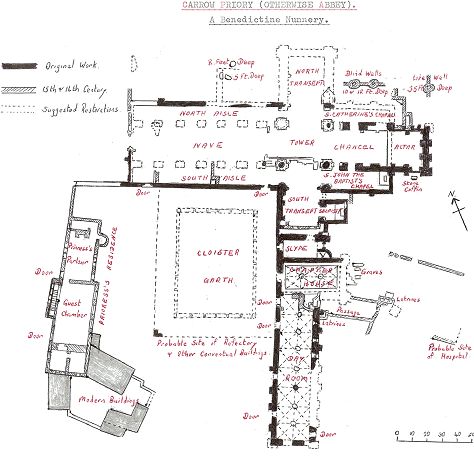 |
| Original photo from 1990 dig showing spiral stair © Albion Archaeology, reproduced with permission |
The 1990 work was overseen by Albion Archaeology from Bedford, and no further traces of Harrold Priory were found. However, based on existing remains and archaeological work on other nunneries in England it is possible to speculate that the steps found at Harrold were the remains of the nuns' 'night stair'. An example of one of these is described by Roberta Gilchrist and Marilyn Oliva at Carrow Priory in Norfolk. This had a layout typical of medieval nunneries, with a row of monastic buildings joining the church at the south aisle - at the same point that the Harrold stair was discovered. Carrow's stairs were in a 'slype' at the south transept, and led down from the nuns' dormitory. They were used to allow the nuns access to their chapel for the night services (matins at 2 am daily).
Carrow's layout, with night and day rooms plus chapter house to the south of the church, and with cloisters attached to the west of these, was common enough both in women's houses and in men's. Carrow had many similarities to Harrold Priory, having been founded in the same period, having been on the edge of a village, and having accommodated a maximum of a dozen nuns. Carrow, like Harrold, was never well endowed and struggled on small benefactions and rents from landholdings.
 |
| Plan of Carrow Priory in Norfolk (source: georgeplunkett.co.uk) |
It is also possible that there was more than one chapel to the south, as can be seen at Carrow. Perhaps the nuns had a private chapel to the south of the chancel (where there are no windows), while there was a new general 'public' aisle to the south of the nave. This again was a common medieval arrangement where the nuns shared their space of worship with the townsfolk. We do know from the Harrold Cartulary (a collection of legal documents, now in the British Museum), that the nuns' chapel was distinct from the main church, as the bishop of Lincoln had to remind the Prioress of her duty to supply bread and wine for both the main church and the nuns' private chapel (Document 207 cited in Fowler 1935).
A conjectural plan of Harrold Priory, taking the Carrow model, would have accommodation extending south from the main church, and forming the east side of the cloister. The west side would be service accommodation - kitchens (possibly with running water in an artificial stream beneath), brewery, dairy, stores, etc. The north side of the cloister would adjoin the church's south aisle while the south side of the cloister would be enclosed. But whereas the nuns of Carrow built a new guest wing and infirmary to the west of the cloister in the late middle ages, at Harrold - we can speculate - a new 'modern' building of this kind went up to the east of the cloister. This was a more serviceable and comfortable building, with the Prioress's private lodgings as well as rooms with fireplaces for corrodians (people who had paid to be cared for in their old age). If the Norfolk pattern from Carrow was repeated in Bedfordshire, at the time of the dissolution this new wing was then remodeled into what then became known as Harrold Hall.
References
- Gilchrist, Roberta, and Marilyn Oliva (1993), Religious women in medieval East Anglia, Norwich: University of East Anglia
- Fowler, G. Herbert (1935), Bedfordshire Historical Records Society volume 17
For more photographs of the Nuns' Stream and other remains, please visit my Harrold Priory collection on Flickr.
No comments:
Post a Comment